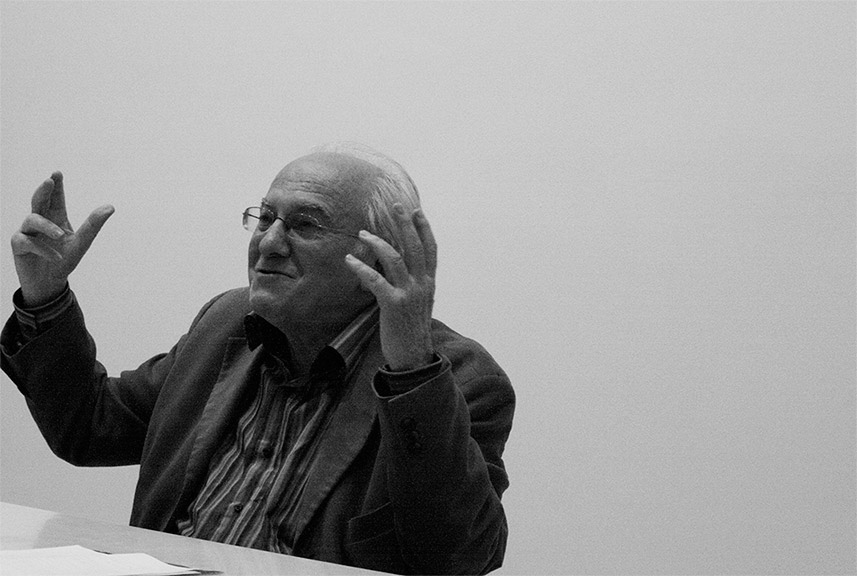Couture, Jean-Pierre. Sloterdijk (Key Contemporary Thinkers). Boston: Polity, 2015. 208 pages. ISBN-10: 0745663818. Hardback, paperback, e-book, 208 pages.
Jean-Pierre Couture’s Sloterdijk is the first comprehensive introduction to the thought of contemporary German philosopher Peter Sloterdijk in English. Given the proliferation of English translations of Sloterdijk’s work in the last several years, and the wide-ranging, often digressive and interdisciplinary nature of Sloterdijk’s career, a formal introduction is as necessary as it is difficult. The difficulty is compounded by the fact that Sloterdijk is still at work writing new texts and intervening in public debates today.
As Couture explains in the introduction to his text, “Interpreting an author’s work during his or her lifetime is not without its many challenges. One does not have the luxury of either a definitive corpus or the passive silence of authors who are no longer with us” (1). Nevertheless, Couture is not intimidated by these challenges and dares to take on the labor of summarizing and synthesizing Sloterdijk’s corpus.
Couture divides his efforts into five chapters. The first three introduce major emergent themes in Sloterdijk’s oeuvre: psychopolitics, anthropotechnics, and spherology. In the first chapter, Couture employs “psychopolitics” as a unifying thread to discuss three of Sloterdijk’s works in particular, Critique of Cynical Reason, Eurotaoismus, and Rage and Time, thereby drawing out continuities among Sloterdijk’s diverse analyses of cynicism, mobilization, and the opposition between eros and thymos (respective to each text). As Couture explains, psychopolitics, in Sloterdijk’s hands, is a Nietezschean project aiming to release his readers from the chains of history and inhibitions, making him a therapist for the “maladies of history.”
In the second chapter on anthropotechnics Couture again finds continuity in Sloterdijk’s work, from the notorious paper “Rules For the Human Zoo” and middle texts like Nicht Gerettet to more recent developments as found in You Must Change Your Life and The Art of Philosophy. Here, too, we discover a Nietzschean impulse, this time one that attests to the “vertical dimension” of human beings, their ability to transcend and transform themselves through practices in light of the revelation that humans are historically contingent and subject to change.
Finally, the third chapter on spherology provides an overarching explanation of Sloterdijk’s magnum opus trilogy Sphären (Spheres), of which only the first two volumes (Bubbles and Globes) currently appear in English. Spherology, Couture summarizes, operates between the “ontologization” of human beings (“setting humans in an original spatiality”) and their “explication” (“making manifest the latent characteristics of human habitats”) (58). Since English readers of Sloterdijk do not yet have access to the full Sphären trilogy, Couture’s attempt to summarize it in its entirety is an enormous gift, even if readers may have to take his interpretation at its word without access to the final text (Foams).
Couture’s handling of these three major themes is particularly useful for two reasons: he brings many untranslated texts into play, offering English readers a window into otherwise inaccessible material, and he articulates the ways in which these themes, which can seem very disparate in Sloterdijk’s work, are, in fact related and in dialogue with one another within Sloterdijk’s career.
In the last two chapters Couture provides invaluable resources for clarifying Sloterdijk’s international reception and open possibilities for English readers. Chapter four, “Controversy,” considers Sloterdijk’s role as a public intellectual in Germany, especially exploring the well-known fireworks surrounding Jürgen Habermas’s reaction to Sloterdijk’s “Rules For the Human Zoo,” a reaction full of seedy and behind-the- scenes schemes against Sloterdijk that feels like an ominous embarrassment for Habermas, the alleged philosopher of communicative discourse.
As Couture presents it, the Habermas-Sloterdijk debacle, and Sloterdijk’s subsequent public denunciation of critical theory (“Critical Theory is Dead”) and its progeny (e.g. Axel Honneth), shows the intrigue and drama behind the dry professionalism of academic philosophy. But Couture is not an uncritical reader aiming to defend Sloterdijk, and he closes the chapter with an excellent series of provocative questions and criticisms aimed at Sloterdijk’s perplexing political conservatism, here attending to a potential discontinuity between Sloterdijk’s early psychopolitical work in Critique of Cynical Reason and his later political sensitivities. In my estimation, the fourth chapter is the most comprehensive and informative introduction in English to Sloterdijk’s controversial context to-date, and it is alone worth the price of admission.
The fifth chapter, “Therapy,” ends Couture’s formal study by providing “an impressionistic portrait of Sloterdijk’s panoply of therapeutic prescriptions” (94), including, among others, discussions of Sloterdijk’s para-academic position, literary style, “poetics of disarmament,” recovery of irreducible intimacy, analyses of religious violence, and gratuitous individualism. Whether one can uncouple Sloterdijk’s therapy from his controversy is left unanswered, but Couture does his best to end on a largely affirmative note (that is, not an endorsement, but a more sympathetic and less polemical presentation).
Sloterdijk emerges from this chapter like one carrying on the spiritual exercises of ancient philosophy as identified by Foucault and Hadot, offering tools for healing and self-control. Couture’s five chapters are book-ended by an introduction and conclusion that situate Sloterdijk biographically in such a way that some of the more face-value bizarre or unfamiliar themes in the latter’s work are made historically discernible.
Couture’s introduction does have some permeating problems. Sloterdijk’s own writing is often made of very purple prose and takes plenty of literary license such that sometimes he is carried away by his style, and his insights with him. Couture occasionally falls prey to this same temptation, explaining stylistic turns of phrase with his own stylistic turns of phrase in a way that sometimes compounds the problem (e.g. the spherology chapter has us boarding a streetcar where Sloterdijk serves as tour guide to the history of humans and space, a device that oscillates between intriguing and unhelpful, but is, if nothing else, a bit of imaginative fun).
In terms of approach, Couture admits up front that his study “is critical in nature” and that he engages Sloterdijk from his own background in political science such that he might articulate the limits of Sloterdijk’s Nietzschean streak. This approach is incredibly helpful in elucidating some of complexities of Sloterdijk’s conservatism and especially the dangers of Sloterdijk’s political writings for the contemporary world scene, rightly interrogating Sloterdijk’s elitism and idiosyncratic critiques of leftist revolutionary thinking.
At the same time, however, one wonders if all of the moves Couture identifies as conservative really are such and whether or not Sloterdijk’s conservatism might even be more complicated than Couture lets on. As the saying goes, when you have a hammer, everything looks like a nail. If one were to approach Sloterdijk from the perspective of media theory, for example, one might hear more clearly Sloterdijk’s affinities for some of the theoretical moves of Paul Virilio, Boris Groys, or Régis Debray, committed leftists (and Sloterdijk’s friends), and his opposition to the vision of globalization offered by conservative Catholic Marshall McLuhan. One could do the same from the vantage point of a variety of other disciplines Sloterdijk straddles (anthropology, sociology, various traditions of philosophy, etc.).
That is not to say Sloterdijk would be excused or exonerated for his reactionary politics, or that he would be redeemed by association (and, for that matter, we should be careful not to make him guilty by association), but rather that other approaches might serve to clarify the proper targets in Sloterdijk’s varied corpus when aiming to root out his conservatism, and they might also help to further sift what remains legitimately unique and innovative in Sloterdijk’s winding career. In other words, these efforts would not dismiss Couture’s major arguments with Sloterdijk but would enhance and extend Couture’s efforts.
All things considered, Couture’s is a capable and compelling introduction to an influential and creative thinker. The foregoing criticisms are inevitable problems for any brief introduction, especially an introduction to someone like Sloterdijk known for boundary-crossing “centauric writing.” Couture’s handling of Sloterdijk’s criss-crossing web of descriptions, prescriptions, and subscriptions gives readers a great orientation to what can be a dizzyingly high altitude of prose.
Most importantly, Couture accomplishes what all good introductions ought to accomplish by making the reader want to take up Sloterdijk’s text on its own terms. May it be the first among many such attempts to grapple with Sloterdijk’s still-evolving body of work.
Dean Dettloff is a PhD candidate at the Institute for Christian Studies, where he works on the intersections of media theory, religious studies, and critical theory. His MA thesis, also at ICS and examined by Robert Sweetman, James Olthuis, and Eduardo Mendieta, considered Peter Sloterdijk’s early work on cynicism and later work on religion. In doctoral work he continues to explore the ways in which philosophy of design and technology, as expressed by Régis Debray, Paul Virilio, Vilém Flusser, and Sloterdijk in particular, illuminate “religious” phenomena and practice in a way that might contribute to more liberating expressions of spiritual traditions foreclosed both by static dogmatism and the impositions of political secularism.




